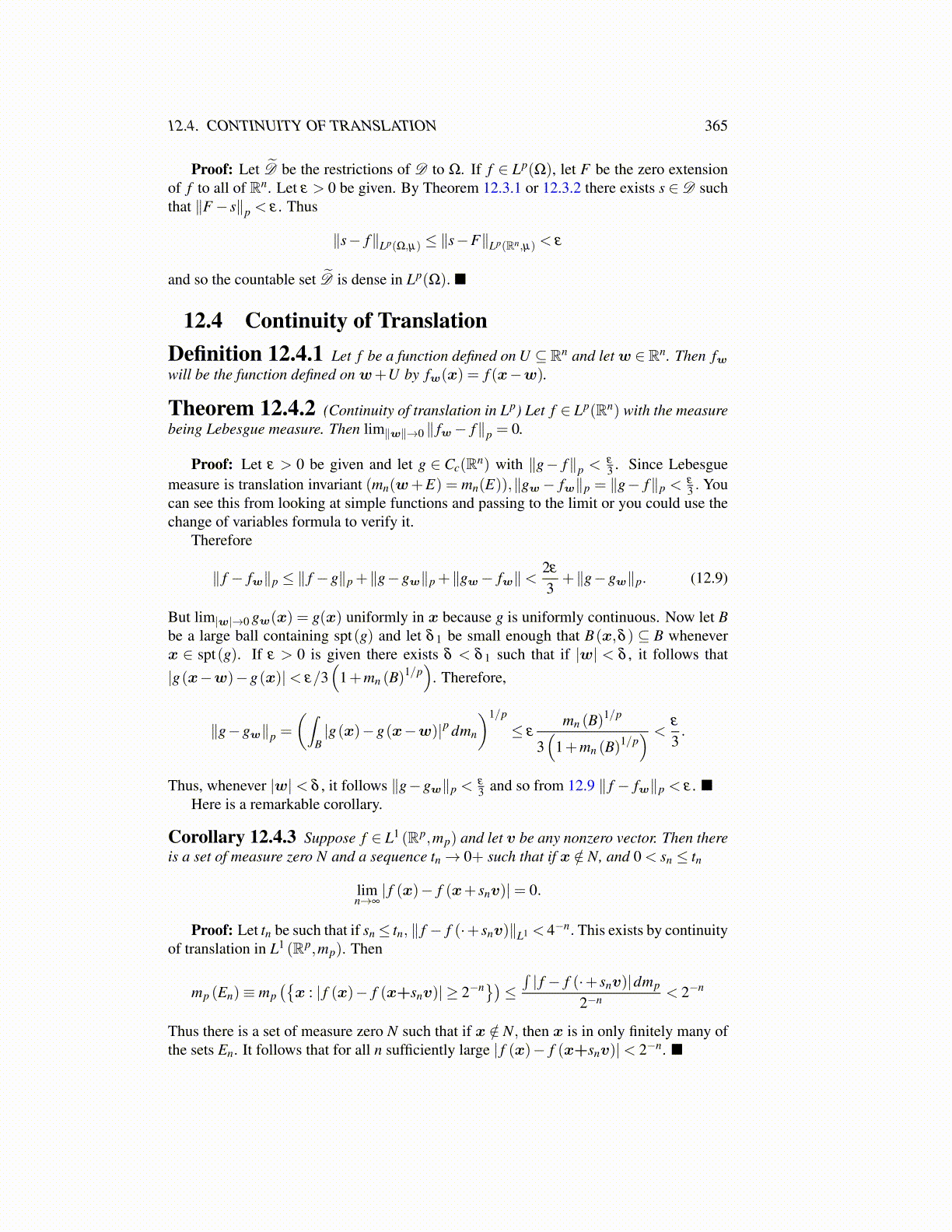
12.4. CONTINUITY OF TRANSLATION 365
Proof: Let D̃ be the restrictions of D to Ω. If f ∈ Lp(Ω), let F be the zero extensionof f to all of Rn. Let ε > 0 be given. By Theorem 12.3.1 or 12.3.2 there exists s ∈D suchthat ∥F− s∥p < ε . Thus
∥s− f∥Lp(Ω,µ) ≤ ∥s−F∥Lp(Rn,µ) < ε
and so the countable set D̃ is dense in Lp(Ω). ■
12.4 Continuity of TranslationDefinition 12.4.1 Let f be a function defined on U ⊆Rn and letw ∈Rn. Then fwwill be the function defined on w+U by fw(x) = f (x−w).
Theorem 12.4.2 (Continuity of translation in Lp) Let f ∈ Lp(Rn) with the measurebeing Lebesgue measure. Then lim∥w∥→0 ∥ fw− f∥p = 0.
Proof: Let ε > 0 be given and let g ∈ Cc(Rn) with ∥g− f∥p < ε
3 . Since Lebesguemeasure is translation invariant (mn(w+E) = mn(E)),∥gw− fw∥p = ∥g− f∥p <
ε
3 . Youcan see this from looking at simple functions and passing to the limit or you could use thechange of variables formula to verify it.
Therefore
∥ f − fw∥p ≤ ∥ f −g∥p +∥g−gw∥p +∥gw− fw∥<2ε
3+∥g−gw∥p. (12.9)
But lim|w|→0 gw(x) = g(x) uniformly in x because g is uniformly continuous. Now let Bbe a large ball containing spt(g) and let δ 1 be small enough that B(x,δ ) ⊆ B wheneverx ∈ spt(g). If ε > 0 is given there exists δ < δ 1 such that if |w| < δ , it follows that|g(x−w)−g(x)|< ε/3
(1+mn (B)
1/p)
. Therefore,
∥g−gw∥p =
(∫B|g(x)−g(x−w)|p dmn
)1/p
≤ εmn (B)
1/p
3(
1+mn (B)1/p) <
ε
3.
Thus, whenever |w| < δ , it follows ∥g−gw∥p <ε
3 and so from 12.9 ∥ f − fw∥p < ε . ■Here is a remarkable corollary.
Corollary 12.4.3 Suppose f ∈ L1 (Rp,mp) and let v be any nonzero vector. Then thereis a set of measure zero N and a sequence tn→ 0+ such that if x /∈ N, and 0 < sn ≤ tn
limn→∞| f (x)− f (x+ snv)|= 0.
Proof: Let tn be such that if sn≤ tn, ∥ f − f (·+ snv)∥L1 < 4−n. This exists by continuityof translation in L1 (Rp,mp). Then
mp (En)≡ mp({x : | f (x)− f (x+snv)| ≥ 2−n})≤ ∫ | f − f (·+ snv)|dmp
2−n < 2−n
Thus there is a set of measure zero N such that if x /∈ N, then x is in only finitely many ofthe sets En. It follows that for all n sufficiently large | f (x)− f (x+snv)|< 2−n. ■